Review: Samsung Galaxy S7 Edge for Verizon Wireless
Mar 17, 2016, 3:30 PM by Eric M. Zeman
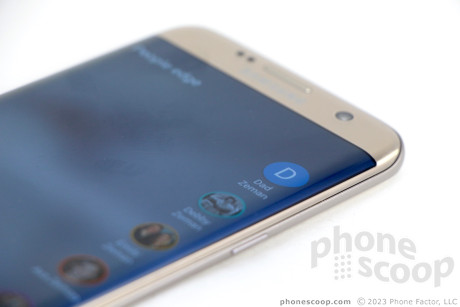
Samsung's top-of-the-line smartphone for 2016 is the Galaxy S7 Edge. This curvy beauty is a powerful addition to Samsung's roster of Android smartphones. It impresses with its high-quality design, materials, and build. The rounded glass edges and larger battery give the S7 Edge an (ahem) edge over the smaller S7. Here is Phonescoop's in-depth review.
Hardware
Editor's Note: Because the S7 Edge is so similar to the S7, some portions of this review have been carried over from our in-depth look at the S7. We fully tested the S7 Edge.
Is It Your Type?
The Galaxy S7 Edge may be Samsung's ultimate Goldilocks phone. It's bigger and more interesting than the standard S7, but smaller and easier to use than last year's S6 Edge+ and Note 5. Like the S7, the S7 Edge represents Samsung at its absolute best in terms of hardware design, engineering, and manufacturing. The Galaxy S7 Edge delivers refined and balanced performance in nearly every respect, but this smartphone will really set you back some Benjamins. In other words, the S7 Edge is for people who want the best and are willing to pay for it.
Body
The Galaxy S7 Edge and its brother, the S7, are works of art disguised as pieces of technology. They show off Samsung's best thinking and execution. The S7 Edge and S7 are not perfect, but they're getting close.
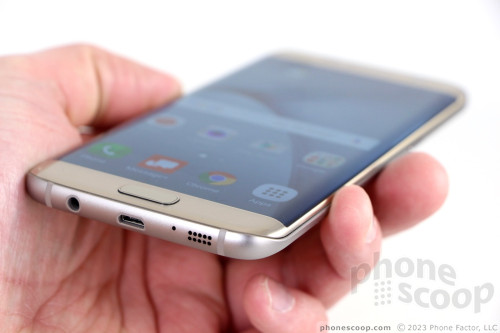
Samsung's flagship phones made a big jump between 2014 and 2015 when the company ditched plastic in favor of metal and glass. The improvement in quality was enormous. Samsung largely recycled the basic design of the S6 Edge/Edge+ for the S7 Edge, but smoothed out most of the rough spots. For example, the rear glass panel is now curved at the edge to meet the frame of the phone, giving the S7 Edge a more rounded look and feel.
My favorite improvement? The frame along the side edges doesn't cut into your palm as it did with the S6 Edge+. This is in part because the joints between the glass and aluminum are more seamless all the way around. It also helps that the S7 Edge is narrower than the S6 Edge+. The metal frame is thick along the bottom and top edges (like the S7), but noticeably thinner as it runs up the sides, where the screen bends around. In fact, the side frame of the S7 Edge is probably 40% thinner than the frame of the S7.
In terms of size, the S7 Edge falls in right between last year's S6 Edge and S6 Edge+, and that's a good thing. The S7 Edge is larger than the S7, too, thanks to the difference in screen size (5.5 inches v. 5.1 inches). Most people will view the iPhone 6s Plus as the chief competitor to the S7 Edge. The S7 Edge is far smaller than the iPhone 6s Plus, even though the screens are the same size. There's no doubt in my mind the S7 Edge wins for hardware usability when pitted against the 6s Plus. It's not as compact as the standard S7, but I still found the S7 Edge very comfortable to use one-handed.
Samsung used top-notch materials to assemble the S7 Edge. The aluminum frame is strong, and the glass panels are fitted into the frame precisely. You simply can't ask for a more refined and thoughtfully crafted handset. Samsung was sure to assemble the S7 Edge as tightly as possible. It's a dense piece of hardware, and you can tell by its heft. The phone slips into pockets with ease, and is just as easy to retrieve. It is mostly glass, though, so if you drop the S7 Edge onto a hard surface, well, good luck with that. Some may feel compelled to protect the S7 Edge with a case, which of course makes it bigger and detracts from its aesthetic appeal.
The phone's front face is classic Samsung and in lockstep with the company's recent designs. The metal frame has a matte finish that I prefer to chrome. The glass on our review unit is rose gold, but the phone also comes in black, silver, and white. A color-matched grille covers the earpiece speaker. Several sensors and the user facing camera are plainly visible. An oval-shaped home button (that doubles as the fingerprint sensor) rests below the display. It has a raised profile to make it easier to find and use. Unlike previous designs, the button's rim is not chrome and instead blends in with the rose gold glass. Travel and feedback are excellent. Two capacitive controls sit on either side of the home button, with multitasking on the left and back on the right. The capacitive buttons work fine, though the placement is counter-intuitive (the back button would make more sense on the left.) The 5.5-inch display fills the bulk of the phone's face. The bezel between the curved edges of the display and metal frame have been reduced from maybe 3mm on the S6 Edge to perhaps 1mm on the S7 Edge. The effect is noticeable in improving the display-to-bezel ratio.
Samsung placed the volume buttons on the left side of the phone. They are positioned close to the top edge. Samsung nailed the profiles, action, and feedback of these keys. I really like these buttons. The screen lock button is positioned closer to the middle of the right edge. It's well-placed, easy to find, and pleasing to use. You'll find no chintzy components here.
The combo SIM/memory card tray is buried in the S7 Edge's top edge. Samsung is offering only a 32 GB variant of the S7 Edge to US consumers, but the memory card slot supports microSD cards up to 200 GB. The tray is a little janky. It's plastic, not metal, and it takes some coordination to properly insert it with a SIM card and memory card. (Bringing back the memory card slot rights one of the wrongs Samsung made with the GS6.) Like last year's Galaxy S, the bottom of the phone is a busy place: it holds the headphone jack, micro USB port, microphone, and speaker. Everything looks precisely machined and works as intended/expected.
Since it's made of glass, the S7 Edge's rear panel cannot be removed. That means, too, that the battery is sealed tightly inside. The S7 Edge is slightly thicker than the S6 Edge and Edge+. This helps it do a few things, one of which is to bury the camera module deeper into the body. The S7 Edge's camera module has a rim that sits just a little bit above the surface of the rear panel. The S6's camera module protruded much more. We've gained a more seamless rear surface and larger battery at the expense of a thicker phone. The S7 Edge keeps the LED flash and heart rate monitor close to the camera. The only other design elements on the back are the Verizon logo and Galaxy S7 Edge branding, painted in shiny chrome.
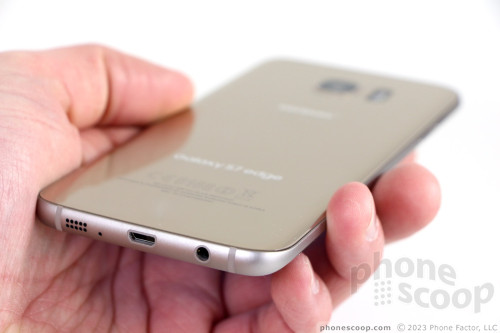
Did I mention that the S7 Edge is water resistant? It is. In fact, it can sit in 1.5 meters of water for 30 minutes and emerge unscathed. This is a big deal. So many people drop their phones in the toilet (gross), pool, or sink and ruin it. The S7 Edge is slim, attractive, waterproof and doesn't have any ugly hatches protecting the ports. Samsung's engineering team did a great job. This is another reason the S7 Edge is a bit thicker — the extra girth helps the interior accommodate the needed elements to prevent water from seeping in. I tested the S7 Edge in the shower, in the sink, and even dropped it in my morning cereal. The phone is as waterproof as the bulky rugged phones made by the likes of Kyocera, CAT, and Sonim. That's impressive.
The Galaxy S7 Edge is a state-of-the-art handset in every sense. I find it more appealing than the S7 from a design perspective, but some might prefer the latter's smaller footprint.
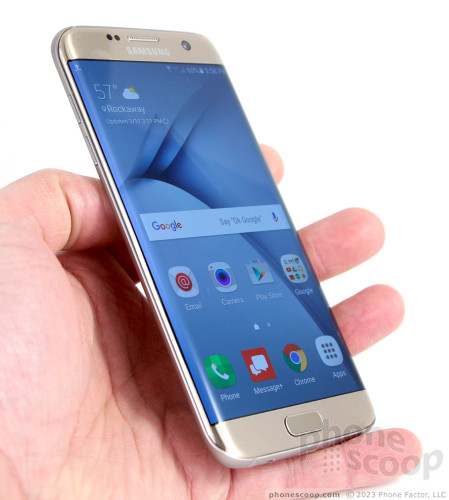
Screen
The S7 Edge's larger, curved display is one of the main features that separates it from the S7. The screen measures 5.5-inches across the diagonal and it boasts quad HD resolution. Samsung favors Super AMOLED displays, and the S7 Edge's is lovely. The screen carries the same number of pixels (3.67m) as the smaller S7, so that means the pixel density on the Edge's screen is slightly less. While this is technically true, it's splitting hairs. At 576ppi (S7) to 534ppi (S7 Edge), your eyes can't tell the difference. The S7 Edge is one of the sharpest displays available. I found it to be nice and bright, without the overly garish color representation that's typical of Samsung phones. That means it's more accurate. I didn't have any trouble using it outside under the sun.
The only complaint I have pertains the fancy curved edges. Because the screen is actually curved, the viewing angles of the side edges are impacted a bit. This means if you view a white screen head on, the sides appear a bit blue. Conversely, if you view the S7 Edge from an angle, the side edge is purer white, while the flat part of the screen turns a little blue. It's a minor issue.
You probably don't need a quad-HD display in your phone for normal use, but it makes a big difference for VR.
Signal
The S7 Edge runs on Verizon's LTE network and behaved exactly like the S7. Tested around the NYC metro area, it performed on par with other Verizon devices but it didn't bowl me over. Calls connected on the first dial without fail and the phone didn't drop any calls, even in a moving car. Under weak conditions the S7 Edge did miss a few calls that went straight to voicemail, but I was able to connect calls in all coverage conditions, weak and strong. On the data side of the equation, the S7 Edge was quick to download apps, load web pages, and scroll through image-heavy apps such as Facebook and Instagram. I've seen faster peak download speeds from other devices, but I can't rule out that I ran into network/location issues, rather than a problem with the S7 Edge. My guess is most people will be pleased with the S7 Edge's performance.
Sound
Like the smaller S7, voice calls sound great via the Verizon S7 Edge. I was very pleased with the phone as far as its actual phone functions are concerned. Voices in the earpiece were plenty loud, enough so to overcome most typical spaces in which you might find yourself (home, office, car). Voices sounded clear to my ears. There was no distortion or breakup, even when the volume was set up all the way. I wish calls sounded a bit warmer, but volume and clarity are more important than timbre. Those I spoke to through the S7 Edge said I was loud and clear.
The speakerphone maintains a good volume level, and clarity drops just a little bit. I was able to hear calls via speakerphone in the car, outdoors, in my home, and so on. The speakerphone was a bit more prone to distortion than the earpiece, but not overly so.
Ringers and alerts reach klaxon levels and will jolt you from the deepest slumber. The vibrate alert is just barely good enough.
Battery
Another reason the S7 Edge is thicker than the S6 Edge is to accommodate the larger battery. Samsung increased the power source from 2,550 mAh to a whopping 3,600 mAh. The difference is incredible. Where the S6 Edge just barely eked out a full day of use — and often didn't — the S7 Edge reliably provides usable uptime between breakfast and bedtime. I was not able to drain the battery fully, not once, despite repeated attempts over several days of testing. I was sure to stream YouTube videos, stream Pandora playlists, browse the web, page through Instagram, and spend plenty of time perusing Facebook. The S7 Edge managed to end each day with at least 25% left, if not more. That's good news. The S7 Edge outperformed the standard S7 (which has a smaller battery) by a noticeable margin.
The S7 Edge includes the typical set of Samsung power management tools. Samsung's Power Saver mode and Ultra Power Saver mode each offer distinct benefits. The former tones down the screens, notifications, and the processor to drum up a bit more life from the battery. The latter puts the phone into ultra basics mode with a greyscale screen and severely limits apps to push through hours of basic communications.
The S7 Edge supports Quick Charge and rapid wireless charging. When plugged into the included charger, I found the S7 Edge charged from 25% to 100% in 100 minutes (longer than the S7 by about 10 minutes). Wireless charging took a bit longer, too, at 3 hours, but that's still pretty good.
Bluetooth, GPS, NFC, WiFi
Samsung was sure to endow the S7 Edge with the usual set of radios for secondary communications. The S7 Edge supports Bluetooth 4.2 and the typical set of profiles for connecting to accessories, computers, and vehicles. The phone pairs easily with everything. Phone calls sent to mono headsets and my car's hands-free system were very good. I was impressed with the clarity of calls through a headset, in particular. Music pushed to my favorite Bluetooth speaker was also very good, but I've heard better.
The S7 Edge's NFC radio was instrumental in helping pair the device with several of these Bluetooth accessories. In other words, it works as intended. The NFC radio may also be used with Android Pay, which is preloaded on the phone, and Samsung Pay, which is available as a separate download from the Google Play Store.
I tested Samsung Pay with the S7 Edge and it worked, though it's not as easy nor as seamless as Apple Pay is on the iPhone. Despite Samsung's claims that Samsung Pay is available at most credit card terminals (NFC and magnetic stripe), I've found Samsung Pay only works at about 50% of terminals. I saw plenty of error messages and watched as a number of sales clerks grew impatient as I fumbled with Samsung Pay. Samsung Pay is definitely more widely available than Android Pay, which is limited to NFC, so guess I'd go with Samsung's mobile payment service over Google's for the time being.
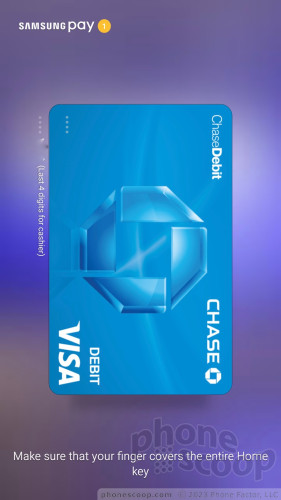
Google Maps pinpointed my location on the S7 Edge faster than it has with any other device. We're talking 2 or 3 seconds. Accuracy was down to 20 feet, which is about as good as it gets. Not only is the S7 Edge quick and accurate with respect to location, but it worked flawlessly with Google Maps to serve as a powerful navigation tool.
The WiFi radio was impressively quick.
Software
Lock Screen
Samsung is (finally) taking a page from some of its competitors when it comes to the lock screen. The biggest and most important change is the inclusion of an "always on" screen that shows the date, time, battery level, and core notifications from email, messaging, and the phone. This way you can snag a quick status update without pressing any buttons or waking the phone up. It's truly helpful. Like the Lumia Glance Screen, the S7 Edge's status tool floats around the display sort of like an old-school screen saver. Nostalgia!
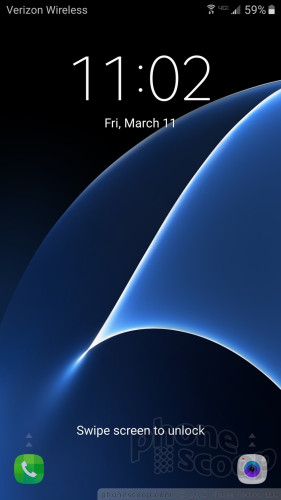
Other than this change, the lock screen works mostly as it does on every other Android smartphone. Pressing the home button or screen lock button will fully wake the display and you'll see the time, date, notifications, and several app shortcuts. I like that you can customize how much detail is revealed by the individual notifications. (If you care to burrow deep into the settings menu you can tweak exactly how each app is allowed to notify you.) The lock screen includes shortcuts to the phone app and camera. You can't customize the app shortcuts, which is a bit of a shame.
The physical home button doubles as a fingerprint reader. That means you can use your fingerprint to secure the phone. I trained several prints and found it to be mostly reliable. It's not quite as quick as the print readers on the iPhone 6s or One A9, but it is quick enough for daily use. Other security options include patterns, PINs, and passwords, which can be set to switch on immediately or after a specified interval. Choose wisely.
Samsung did give the S7 Edge one leg up on the S7: the edge screen itself can be turned on indefinitely when the rest of the display is off to show the time, date, and notifications. Third-party apps are able to take advantage of this, too, such as Twitter and Yahoo news, which will show inbound content via the edge screen if you want. Last, the edge screen can serve as a night clock if you want.
Home Screen
The Galaxy S7 Edge runs Android 6.0 Marshmallow. That means it includes some of the core new features from Google, such as Doze and Now On Tap. As expected, however, Samsung once again plastered its TouchWiz UI on top of the base platform. The results are mixed, but not all that different from any other phone Samsung has released in recent memory.
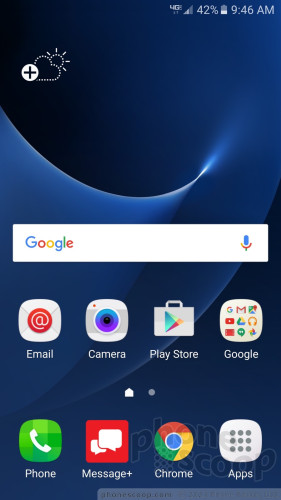
There are just two home screen panels active out of the box and they are filled with an assortment of Samsung and Verizon apps and services. It takes some effort, but you can clear away the junk and customize the home screen panels with the apps, shortcuts, and widgets of your choosing. I like that Samsung allows you to assign which panel is the home panel, such as the middle screen or left-most screen, etc. You can activate the Briefing panel (which is Flipboard) if you want, or ignore it. If activated, Flipboard automatically becomes the left-most panel.
One thing I dislike: the button to access the app drawer is anchored to the far right of the home screen dock. I prefer the button to be in the middle, but Samsung won't let you move it around. Worse, the dock only fits four buttons across where many phones fit five buttons. Oddly, you can adjust the size of the home screen panel grid between 4x4, 4x5, or 5x5 icons, depending on how many apps you want on each screen. Doing this, however, doesn't change the 4-icon limit in the dock. C'mon, Samsung!
As for the app drawer, Samsung organizes it into horizontal panels that move sideways one full screen at a time. I prefer the smooth vertical scrolling of stock Android. Out of the box, there is a single panel that has a handful of folders jammed with Verizon, Samsung, and Google apps. Samsung normally allows users to choose between alphabetical order, custom order, or order based on frequency. Typically, if you choose alphabetical order, which is what I prefer, all of the apps are pulled out of folders and listed individually. On the S7 Edge, choosing the alphabetical arrangement doesn't pull the folder-bound apps out. This is really annoying to me. You can take the time to individually remove the folders. These are small complaints, I suppose, but the S7 Edge is harder to tweak in this regard than the S6 or other Samsung Galaxy phones.
There is no change to how Samsung treats the settings screens. You can choose to add some of your most-used settings tools to the top of the screen; otherwise, all the settings are arranged into the usual clumps (radios, personalization, accounts, system, and so on.) The same goes for the Quick Settings panel and notification shade. Samsung changed up the fonts, colors, and icons, but the underlying functionality of the Quick Settings panel is unchanged. That means you can tweak where the toggles land for controlling various radios, and such.
When it comes to personalization, the S7 Edge includes an expanded set of themes. Themes override everything: fonts, colors, icons, graphics, wallpapers, and more. There are just two alternate themes preinstalled on the phone. If you want more, you'll have to create a Samsung account to download them. That's annoying and pretty much guarantees I won't be downloading more themes. Creating a Samsung account is free, and most of the themes are free, too. The usual tweaks are all available, such as ringers, alerts, yadda yadda yadda.
You can multitask on the S7 Edge by running two apps at the same time in separate windows. Not all apps are supported, but those that are have a distinct icon (two rectangles on top of one another) to indicate their compatibility with the tool. It works fine and takes maybe 60 seconds to master.
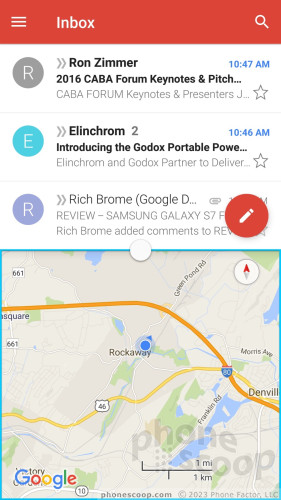
The S7 Edge includes TouchWiz Easy Mode, which gets rid of the complicated home screen panels and app drawer in favor of larger icons and fewer screens through which to navigate. This tool is meant for people who may be new to smartphones, or those who have seriously bad eyes.
You can use a number of different hand gestures to control the phone. For example, you can capture a screenshot by swiping the edge of your hand across the display, or call the contact whose call log, message, or contact details are on the screen by bringing the phone to your ear. Incoming calls can be muted by placing your hand on the screen or turning the phone over.
On the performance front, the S7 Edge has a Snapdragon 820 processor with 4 GB of RAM. The 820 is Qualcomm's top-of-the-line chip, and 4 GB is a whole lot of RAM for a phone. In fact, Qualcomm has been yammering about the 820 for nearly 9 months. The 820 is a SoC that bundles together blazing quick processor cores with a GPU, ISP, and LTE radios. The S7 Edge is one of the first — if not the very first — devices to ship with the 820 inside. (Some international models of the S7 Edge use Samsung's Exynos Octa chip, but all US variants run the 820.) Um, yeah, it's fast. The phone does everything lickety split. You won't see any staggering, slowness, or lagging with the S7 Edge. It performed every task I set before it without hesitation.
Edge Screen
Samsung overhauled the Edge Screen software on the S7 Edge to make it more useful. It is, but it's somehow now also less relevant.
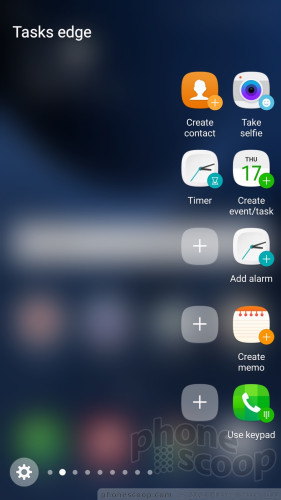
Like before, Edge content is available by swiping a thin tab that appears on the curved part of the screen. You can position the tab anywhere along either side of the S7 Edge's screen. You can choose how large the tab is, as well as how transparent it is. When swiped open, the Edge panel now accommodates two rows of icons for apps or contacts, and can handle more usable (i.e., readable) content, including actual articles. In other words, Samsung went with MOAR. Great.
The phone ships with 11 slices of content for the Edge panels: app shortcuts, more app shortcuts, contacts, headlines, Milk Music controls, profiles/settings for ringers and alerts, stocks, scores, compass, calendar, and weather. Each of these panels can be customized to suit your individual tastes and needs. More Edge panels are available for download from Samsung (Samsung account required) if you feel these 11 aren't enough. For example, I'd replace Yahoo news with CNN, and dump the stocks for a messaging window. Only 9 Edge panels can, however, be active at any one time.
The panels work fine, and I like the flexibility afforded by the revised Edge screen behaviors. They each offer a snapshot of the content you want as well as the option for accessing more content, notifications, or details. The original idea behind the Edge screen was to provide a "snapshot" of information; a set of quick, glanceable data that could be digested and dismissed. Now, you can read more, see more, do more and that raises the question: why not just open the full app instead?
It essentially boils down to a matter of multitasking and how you choose to handle it. Everyone has a preferred way to deal with certain activities and interruptions. The Galaxy S7 Edge does offer more flexibility in handling multitasking and interruptions than other devices. Don't forget, the S7 Edge already allows you to run two full apps at the same time. The Edge panels are simply a variation on a theme — and are less powerful than half-screen apps on the S7 Edge.
In this case, I'm not sure that "more flexibility" in handling some tasks necessarily equates to "better." To put an even finer point on it, are curved glass and enhanced notifications worth an extra $110 to you? I'd argue that for most people, they aren't.
Camera
The camera app is a carry-over from older Samsung phones, but has a wider array of shooting modes and tools than most. The best way to launch the camera is to double tap the home button. You can do this when the phone is locked. The camera jumps to life quickly so you can capture a shot.
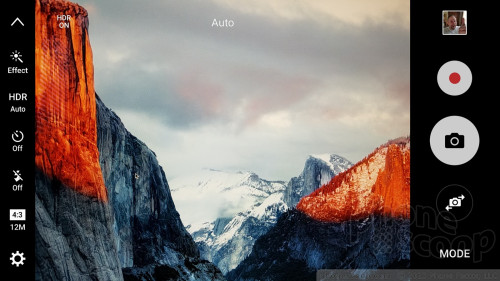
The S7 Edge's camera includes shutter controls and access to the shooting modes and recent photos on the right side of the viewfinder. There are two shutter buttons, one for pictures and one for video, and the shooting modes include auto, pro, selective focus (bokeh), panorama, video collage, live broadcast, slow motion, virtual shot, food, and hyperlapse. None of these modes is really new. I'd recommend most people stuck with the auto settings, as it is the easiest to use, and takes great photos.
The “pro” mode is a manual mode that adds control over white balance, exposure, and ISO, which are not available on the auto mode. You can choose your own shutter speed, too, up to 10 seconds for creative night shots, as well as fiddle with metering and color correction. Select focus allows you to alter which subject is in focus after you've taken the photo. The video collage tool automatically assembles a handful of photos and videos (based on time, location) to create shareable moments. Live broadcast lets you push live video directly to YouTube. The Food tool lets you take close ups of your fancy food and makes the colors look more vivid. Slow motion and hyperlapse do what you expect them to. The virtual shot tool lets you take 360-degree images of stationary objects. For example, you can use it to walk around Michelangelo's statue of David and then see the statue from all sides on your phone. It's tricky to use and takes practice. The rest of these shooting modes are a snap to figure out, and Samsung provides a tutorial if you need it.
An arrow on the left side of the camera UI will drop down a set of icons that let you access effects (sepia, etc.), the timer, flash, HDR, and full settings. You can play with the resolution, location tags, grid lines, and so on, but there are a few more-advanced settings. For example, you can turn on the Motion Photo capture mode, which captures video and images at the same time (like HTC's Zoe and Apple's Live Photos). It works well. The S7 Edge also has a tracking auto-focus feature that lets you select a subject and keep it in focus even if it moves around.
The user-facing camera includes several imaging tools. The basic selfie mode includes a beautification tool that's rather extensive. For example, you can make your face slimmer, make your eyes bigger. add a heavenly shine to your face, as well as play with your skin tone. The selfie came includes a wide-angle mode to fit more people into that group shot, and you can use the live broadcast function when taking selfies, too.
The camera app is very fast. The Snapdragon 820 — along with its dedicated image signal processors and Samsung's software — provide flawless performance of the app itself. You can keep it simple for basic photography if you want, or take advantage of the wide number of features to more creative. It's got something for everyone.
The S7 Edge camera doesn't offer any functionality different from / or additional to the standard Galaxy S7.
Photos
Samsung took a different approach to the camera sensor this year. For a while it seemed as though Samsung might fall victim to the megapixel wars, amping up the number of pixels indefinitely in order to appear more powerful. But photo pros know that megapixels aren't everything, and that has apparently sunk in with the folks over at Samsung. That's why the S7 Edge trades in the 16-megapixel sensor from the S6 for a higher-quality 12-megapixel sensor. Samsung says the pixels are larger to improve low-light capture, among other advantages.

The phone takes darned good pictures. It's probably the best camera available from a modern smartphone, and it definitely goes toe-to-toe with the iPhone 6s and 6s Plus.
Focus is sharp, exposure is dead-on, and colors are accurate. I was very pleased with the results I saw from the camera. The phone does well in bright and dark environments. Shots taken in darker spots were free of grain and noise. The f/1.7 aperture and optical image stabilization help a lot here. It's a fine, fine camera.
The front camera has a 5-megapixel sensor and an f/1.7 aperture and it produces excellent selfies. I find many phones take grainy selfies that look soft and drab. The S7 Edge takes highly accurate selfies (warts and all!) that are crisp, clean, and properly exposed. You're going to be able to take your selfie game to a whole new level with the S7 Edge.
The phone captures video up to 4K, but as always I recommend you stick with the 1080p HD settings. Full HD provides all the pixels you need and the S7 Edge does a great job at delivering sharp, accurate video.
Going on vacation? Leave the dSLR at home. The S7 Edge can handle most of your photography and video needs.
Samsung / Verizon Stuff
The Verizon S7 Edge has 43 apps pre-installed. That's 15 to 20 fewer than past iterations of Samsung's flagship devices. The issue isn't so much volume as it is how aggressive Verizon's apps are. They assault you during the device setup process and, even when dismissed, come back later with reminders to sign up, download this, install that, sync here, and push there. It's way over the top. Verizon's apps border on malware, they're that intrusive.
Verizon also has an app deal with Amazon, which means all Verizon's phones come preloaded with a number of Amazon apps that people may or may not want.
Samsung toned down the presence of its own apps, but they are still there hidden in a folder. (S Health, S Voice, Milk Music, and so on.)
My biggest gripe with all these is that hardly any of the unwanted apps can be uninstalled. Only six of the total can be stripped from the phone, cleaning out space for more. By the way, the phone ships with 32 GB of storage, but only 20.5 GB of that is available out of the box. The system image and preloaded apps consume 11.5 GB. That's kind of absurd. Thank goodness the phone supports 200 GB microSD cards.
Gear VR
Samsung is offering the first wave of S7 Edge buyers the Gear VR headset for free. Don't dismiss this offer, as the headset normally costs $99. In order to get the S7 Edge and Gear VR to play nicely together, you have to download the Oculus Android app, create an account, and all that nonsense. Once you do, you can insert the S7 Edge into the Gear VR headset and explore virtual worlds.
It's pretty darned neat. The software is designed in such as way that you navigate by moving a pointer with your head. A small button on the right side of the Gear VR lets you make selections, and there's a "back" button to help you navigate backward through the menu. The small button takes some practice to use effectively.
The free content that's available in the Oculus app can provide hours of exploration. There are sweeping panoramas of the real world and virtual worlds. Some video content is there to watch, as well. It's truly enveloping and goes far beyond what I've seen from Google Cardboard.
Samsung (and I) recommends that you sit down when using the Gear VR. A spinning chair works best. This makes it easy to see all 360-degrees of the virtual worlds.
Using the Gear VR will take a toll on your battery, but it's worth it for the entertainment.
Wrap Up
The Samsung Galaxy S7 Edge is a bit of a different monster than the S7. It's bigger, has a larger, curved screen that does special things, and has a juicier battery. It's also $780, which is steep hurdle to clear.
Taken as a whole, I like the S7 Edge better than the S7, but only by a bit. I prefer the shape, appearance and bigger screen of the Edge, and appreciate the slightly better battery life.
The hardware borders on perfection with its design, materials, and build quality. Toss in extras like waterproofing and that's just icing on the cake. The S7 Edge has a fantastic screen, provides good voice calls and decent data speeds, and delivers excellent battery life for a handset in this class.
On the software front, TouchWiz is still a bit heavy-handed for my tastes, but the S7 Edge offers an incredible numbers of tools to personalize the handset. You can make things simple or go for the advanced. The Snapdragon 820 processor provides plenty of power and the phone is lightning quick.
The camera is the Galaxy S7 Edge's stand-out feature. It ranks among the best in the market, and offers plenty of flexibility when capturing photos.
If you can live without the S7's edge screen features, which I find a bit underwhelming, the standard S7 goes for $110 less. Even so, the Galaxy S7 Edge is an impressive piece of hardware that I recommend to anyone who can afford it.
Comments
Slight correction in review


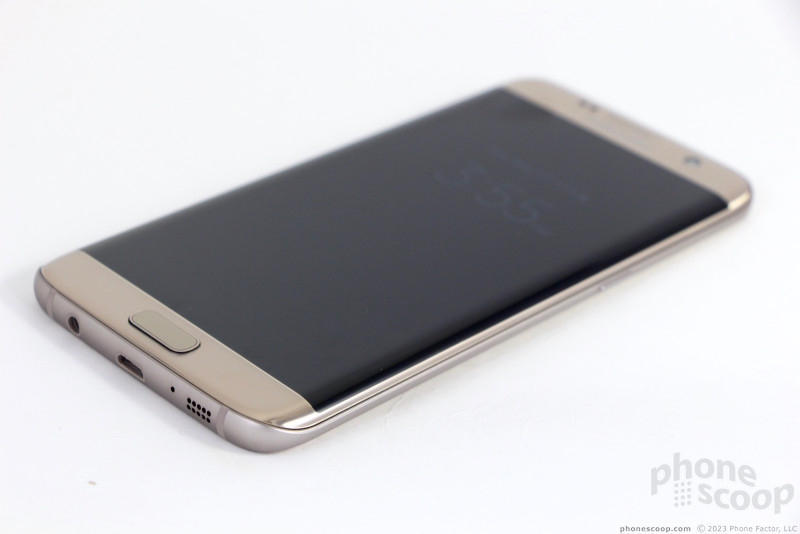















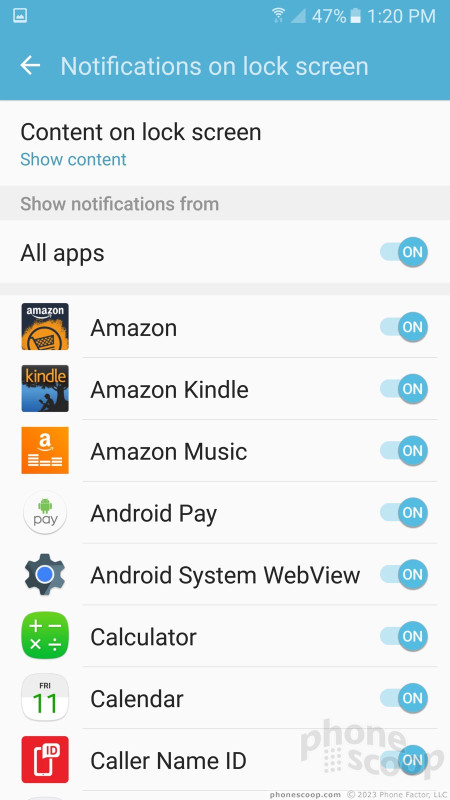



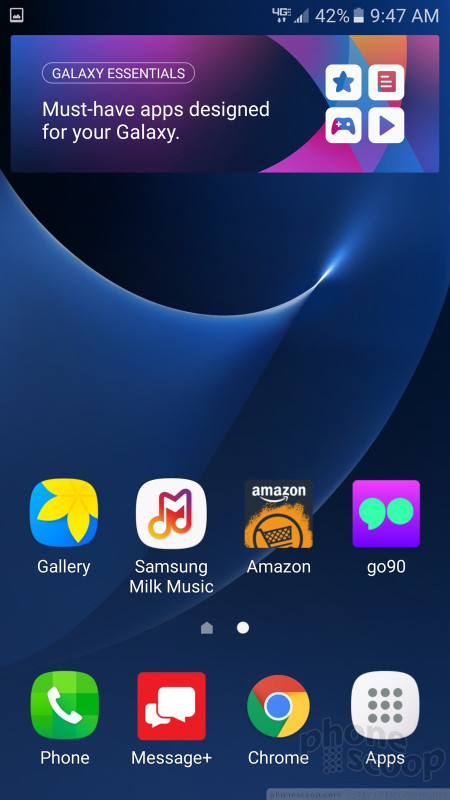





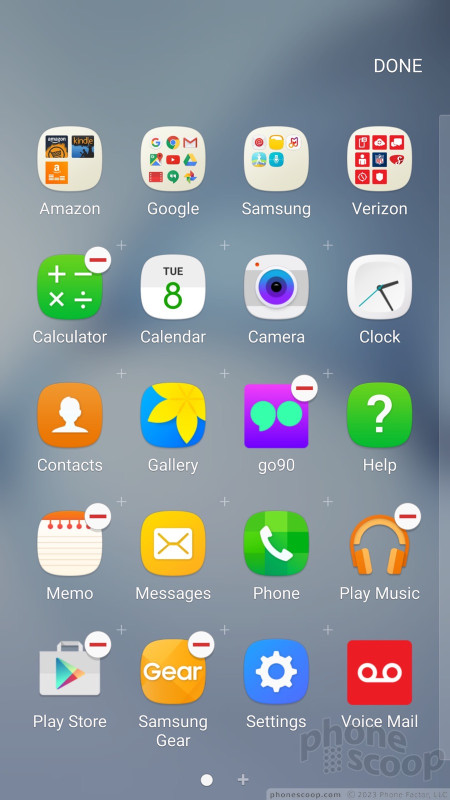






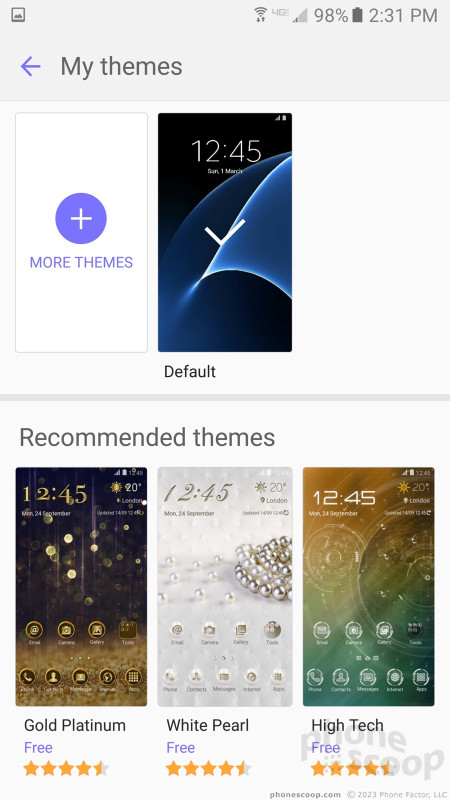



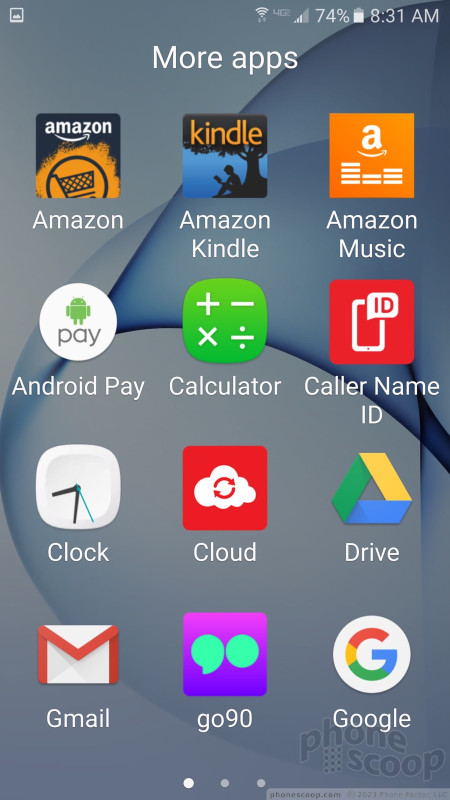





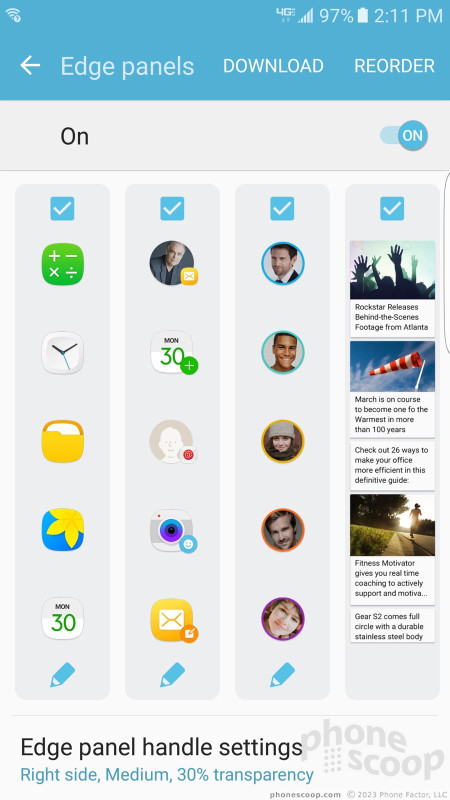










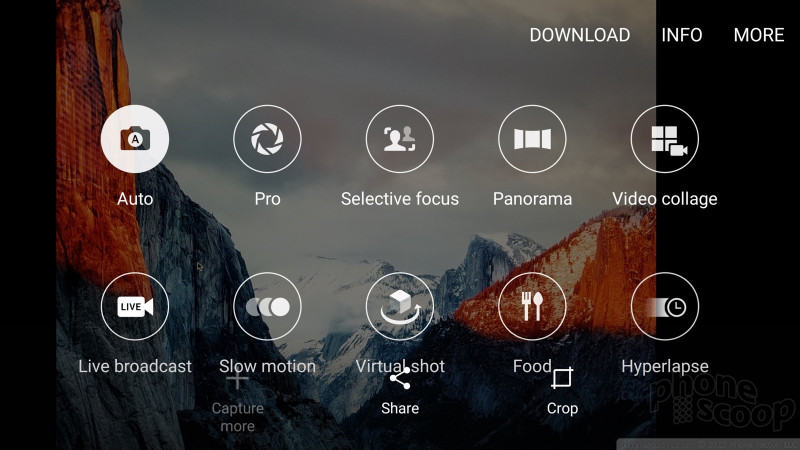


































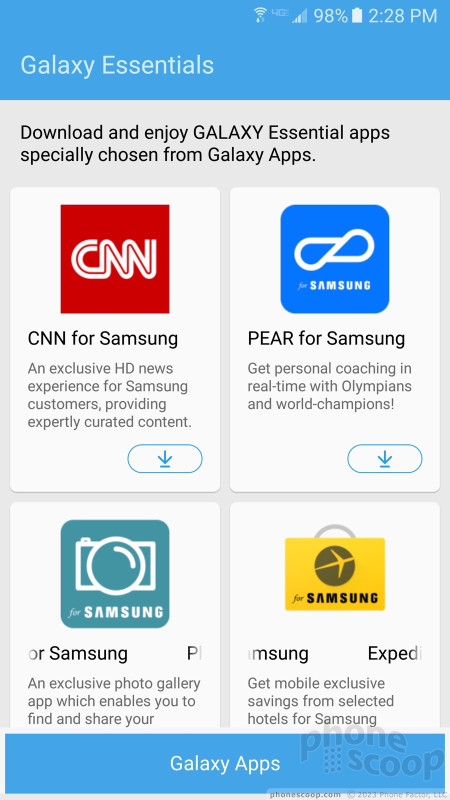



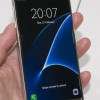 Hands On with the Samsung Galaxy S7 and S7 Edge
Hands On with the Samsung Galaxy S7 and S7 Edge
 Samsung Galaxy S7 Clears FCC with Single Approval
Samsung Galaxy S7 Clears FCC with Single Approval
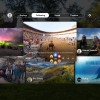 Facebook Trots Out Virtual Reality App for Samsung Gear VR
Facebook Trots Out Virtual Reality App for Samsung Gear VR
 Adobe's Lightroom App Adds RAW HDR Shooting for Android and iOS Phones
Adobe's Lightroom App Adds RAW HDR Shooting for Android and iOS Phones
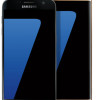 Sprint Flips On 3-Channel Carrier Aggregation for iPhones and Galaxies
Sprint Flips On 3-Channel Carrier Aggregation for iPhones and Galaxies
 Samsung Galaxy S7 edge
Samsung Galaxy S7 edge










